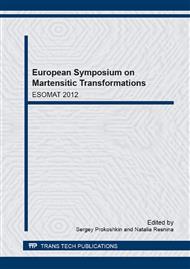p.183
p.189
p.195
p.200
p.206
p.212
p.217
p.222
p.228
Structural and Hardness Gradients in the Heat Affected Zone of Welded Low Carbon Martensitic Steels
Abstract:
Welding of low carbon martensitic steels with yield strengths above 690 MPa requires careful attention to the welding procedure to avoid hydrogen assisted cold cracking (HACC) and to minimise degradation of the mechanical properties of the weldment. Investigations of the microstructural and hardness gradients in the heat affected zone (HAZ) of these types of steels revealed that the peak hardness does not occur in the grain coarsened heat affected zone (GCHAZ) adjacent to the fusion boundary, as normally observed for ferritic steels, but is displaced towards the grain refined region (GRHAZ). This phenomenon, referred to as the displaced hardness peak (DHP) effect, is considered to arise when the hardenability of the steel is sufficiently high to produce the same microstructure in the both the GC and GR heat affected zones, but the enhanced structural refinement of the GRHAZ increases the hardness and strength above that of the GCHAZ. Implications relative to the susceptibility of the weldments to HACC are discussed.
Info:
Periodical:
Pages:
206-211
Citation:
Online since:
January 2013
Authors:
Price:
Сopyright:
© 2013 Trans Tech Publications Ltd. All Rights Reserved
Share:
Citation:


